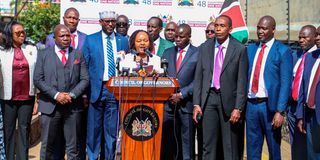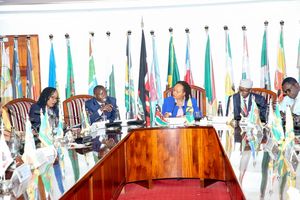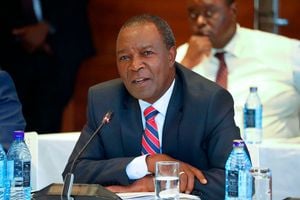
Council of Governors Chair Anne Waiguru (center) flanked by Governor Muthomi Njuki (left), Governor Fernandes Barasa (right) and fellow governors addresses journalists in Nairobi on January 19, 2024.
Counties are grappling with their overwhelming dependence on the national government for funding that has led to a perpetual tug-of-war with the National Treasury over equitable revenue sharing.
This has been compounded by the counties’ failure to meet local revenue targets. In turn, the counties are struggling to deliver essential services.
With the devolved units rapidly increasing their annual expenditures, a stagnation or decline in their disbursements will hit their spending plans hard.
Early this month, county bosses declared a deadlock in the ongoing deliberations over the sharing of revenue with the national government for the 2024/2025 financial year.
In the final 2024 Budget Policy Statement released yesterday, counties’ equitable share allocation was down by Sh10.52 billion to Sh391.1 billion. The draft statement had set the share at Sh401.6 billion. However, the total county allocation (including conditional grants) for 2024/25 is set at Sh445.84 billion up from Sh424.93 billion in 2023/24.
The Commission on Revenue Allocation (CRA) has proposed that the counties be allocated Sh398.14 billion in equitable share, while the Council of Governors (CoG) has proposed Sh439.5 billion and Sh10.52 billion as Road Maintenance Levy Fund.
Senators have questioned the proposed allocation by CRA, saying it is way below the proposal the agency had put out for the current financial year.
Some of the legislators have threatened to reject the revenue allocation proposal on the basis that it presents a marginal increase from the current allocation despite a projected rise in revenue collection by the national government.

Council of Governors chairperson Anne Waiguru (centre) with her colleagues during a past media briefing in Nairobi.
CRA’s proposal is an increase of Sh22 billion compared to the current year, while that of the national government is proposed to be Sh2.25209 trillion, an increase of Sh374 billion.
An analysis shows county bosses have always struggled to secure the envisioned revenue vital for the development and welfare of their respective regions since the inception of devolution. This has been rooted in a web of systemic challenges that shape the financial dynamics between the two levels of government.
Governors have often found themselves at the mercy of bureaucratic time frames and procedures that delay the release of funds, affecting the counties’ ability to plan and execute development projects promptly.
CoG chairperson Anne Waiguru said there is need to ensure counties are cushioned from the rising cost of inflation across various devolved sectors.
According to her, the cost of the devolved unit’s operations and maintenance has also shot up necessitating an increase in their share of revenue.
“Our proposal is also buttressed by the fact that next financial year’s allocation should be increased to factor in emerging items that will occasion additional expenditure by counties such as the new mandatory National Social Security Fund, Social Health Insurance Fund and Housing Levy contributions,” the Kirinyaga governor stated.
Counties are also sagging under debts and a backlog of payments owed to contractors and suppliers.
Section 17 (6) of the Public Finance Management Act requires Treasury to release monies to the counties at the beginning of every quarter but not later than the 15th day from the commencement of the quarter. But this is not complied with.
Own-source revenue from levies, property rates and others has continued to underperform.
In 2022/23,counties generated Sh37.81 billion from own-source revenue, which was 65.9 per cent of the annual target of Sh57.37 billion.
CoG Finance Committee chairperson Fernandez Barasa has advocated for a paradigm shift in revenue collection to reduce over-reliance on equitable share.











